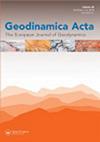A peculiar reworking of Ophiomorpha shafts in the Miocene Nangang Formation, Taiwan
IF 1.5
Q1 Earth and Planetary Sciences
引用次数: 11
Abstract
In the Miocene sandstones of the Nankang Formation in north-eastern Taiwan, different varieties of the trace fossil Ophiomorpha are abundant. In certain beds, a peculiar reworking of vertical Ophiomorpha shafts was observed. This reworking consists of an inner, lined tube positioned in the centre of the shaft. The shaft is lined by thin walls with small knobs and is distinctly different from the shafts of the Ophiomorpha nodosa mazes found in the same beds which have thick walls and large knobs. Because both outer and the inner tube walls were constructed by small sub-pellets, a diagenetic origin can be ruled out. The presence of sub-pellets further indicates that the inner tubes were also constructed by crustaceans and not commensal organisms such as worms or fish. The abundance of these vertical shafts suggests that they were constructed for a specific purpose, and the similarities in sub-pellets indicate that they likely were constructed by different generations of the same crustacean species. Because brooding chambers were not observed and are rare among extant marine crustaceans, we suggest that the vertical shafts were constructed to encourage juvenile shrimp to resettle in the parental burrows after they had completed their pelagic larval stages.台湾中新世南岗组蛇形岩轴的特殊改造
台湾东北地区中新世南康组砂岩中,蛇胚目微量化石种类丰富。在某些床上,观察到一种特殊的垂直蛇胚轴的改造。这种重新加工包括一个内部,内衬管定位在轴的中心。井壁薄,有小旋钮,这与在同一床中发现的蛇胚迷宫的井壁厚,旋钮大有明显不同。由于外管壁和内管壁都是由小的亚颗粒构成的,因此可以排除成岩成因。亚颗粒的存在进一步表明,内管也是由甲壳类动物建造的,而不是蠕虫或鱼类等共生生物。这些竖井的丰度表明它们是为特定目的而建造的,而亚颗粒的相似性表明它们可能是由同一甲壳类物种的不同代建造的。由于在现存的海洋甲壳类动物中没有观察到孵卵室,而且孵卵室在现存的海洋甲壳类动物中很少见,因此我们认为建造垂直轴是为了鼓励幼虾在完成远洋幼虫期后重新定居在亲代洞穴中。
本文章由计算机程序翻译,如有差异,请以英文原文为准。
求助全文
约1分钟内获得全文
求助全文
来源期刊

Geodinamica Acta
地学-地球科学综合
CiteScore
4.50
自引率
0.00%
发文量
0
审稿时长
25 weeks
期刊介绍:
Geodinamica Acta provides an international and interdisciplinary forum for the publication of results of recent research dealing with both internal and external geodynamics. Its aims to promote discussion between the various disciplines that work on the dynamics of the lithosphere and hydrosphere. There are no constraints over themes, provided the main thrust of the paper relates to Earth''s internal and external geodynamics. The Journal encourages the submission of papers in all fields of earth sciences, such as biostratigraphy, geochemistry, geochronology and thermochronology, geohazards and their societal impacts, geomorphology, geophysics, glaciology, igneous and metamorphic petrology, magmatism, marine geology, metamorphism, mineral-deposits and energy resources, mineralogy, orogeny, palaeoclimatology, palaeoecology, paleoceanograpgy, palaeontology, petroleum geology, sedimentology, seismology and earthquakes, stratigraphy, structural geology, surface processes, tectonics (neoteoctonic, plate tectonics, seismo-tectonics, Active tectonics) and volcanism.
Geodinamica Acta publishes high quality, peer-reviewed original and timely scientific papers, comprehensive review articles on hot topics of current interest, rapid communications relating to a significant advance in the earth sciences with broad interest, and discussions of papers that have already appeared in recent issues of the journal. Book reviews are also included. Submitted papers must have international appeal and regional implications; they should present work that would be of interest to many different specialists. Geographic coverage is global and work on any part of the world is considered. The Journal also publishes thematic sets of papers on topical aspects of earth sciences or special issues of selected papers from conferences.
 求助内容:
求助内容: 应助结果提醒方式:
应助结果提醒方式:


